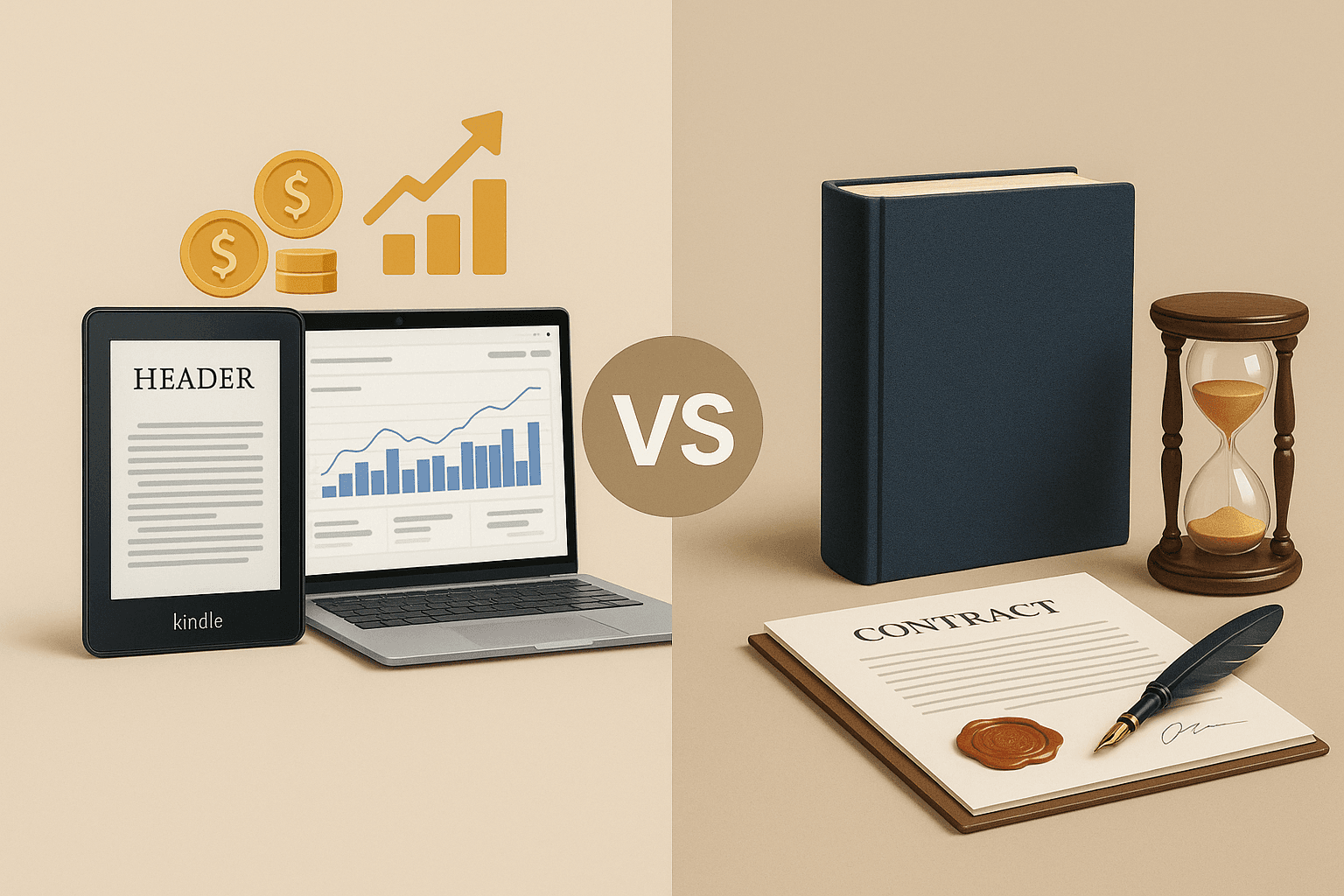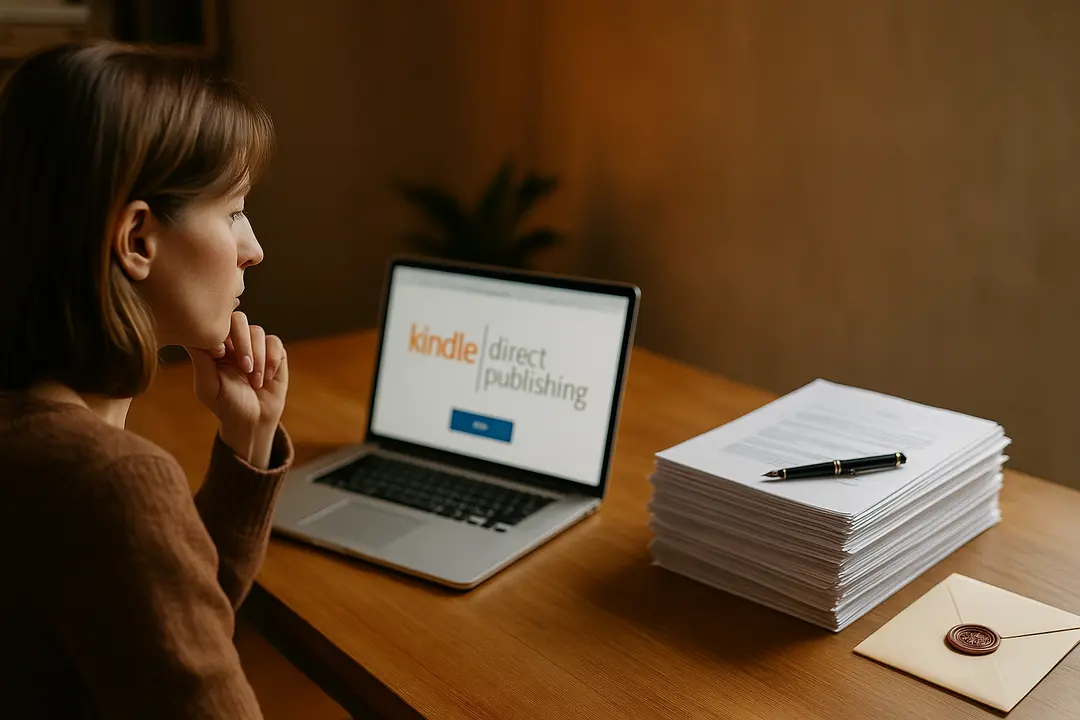KDP vs. Traditional Publishing: What’s Best for Authors?

Are you thinking about writing a book but don’t know where to start? Are you unsure whether to self-publish your book on Amazon KDP or seek a traditional publisher? The right choice depends on your goals, your author profile, and the strategy you choose for your career. In this article, we analyze the pros and cons of each option, share real market data, and give you practical tips to help you make the best decision.
1. What does self-publishing on KDP involve?
Kindle Direct Publishing (KDP) is Amazon’s self-publishing platform. Here, any author can upload their book and sell it globally in digital and print formats. The process is fast, flexible, and, above all, controlled by the writer.
Main Advantages:
- Total control: You decide on the cover, price, descriptions, and marketing strategies.
- High royalties: For ebooks, you can earn up to 70% royalties on the sale price.
- Quick launch: Your book can be available within hours.
- Global reach: Your book is distributed across all Amazon stores (Spain, Mexico, USA, etc.).
- Positioning tools: You can use keywords, select strategic categories, and take advantage of the entire amazon book publishing ecosystem to boost your visibility.
Disadvantages:
- Marketing and visibility are up to you: If you don’t work on your brand and positioning, it will be hard to stand out, especially in such a competitive and unique market.
- Initial investment: Cover design, formatting, editing, and proofreading are your responsibility.
- Fierce competition: Especially in English-language markets; there are fewer Spanish-language books, but also fewer readers.
2. What does publishing with a traditional publisher involve?
Publishing with a traditional publisher means giving up your book rights in exchange for the publisher handling the editing, distribution, and, in theory, the promotion of your book.
Main Advantages:
- Professional support: Editorial team, design, editing, and distribution are guaranteed.
- Validation and prestige: The seal of a traditional publisher can open doors to media, bookstores, and book fairs.
- No upfront investment: The publisher covers production costs and sometimes promotion.
Disadvantages:
- Long processes: It can take one or two years from manuscript submission to publication.
- Less control: You don’t decide on the price, cover, or marketing campaigns.
- Low royalties: Usually between 7% and 10% of the sale price.
- Difficult access: It’s hard to get accepted unless you have a media profile or a highly commercial book.
3. Market data: Sales, growth, and opportunities
Self-publishing on Amazon continues to grow, especially in niche markets and Spanish-language books.
- The Spanish-language book market on Amazon KDP USA grew by 13% in 2024, although it remains small compared to the English market.
- Spain is the largest market for Spanish ebooks (55% of the global total), followed by Mexico (21%) and the USA (10%). However, many authors sell more on Amazon.com due to the user volume and digital reading habits.
- Publishing on KDP gives you simultaneous access to all three markets, and to Latino readers who search both in English and Spanish.
4. How to stand out on Amazon KDP?
- Choose your niche carefully: Research competition and demand before you start. Analyze which categories are profitable and have manageable competition.
- Optimize your book page: Attractive cover, engaging synopsis, and strategic use of keywords and categories.
- Invest in digital marketing: Run ads (Amazon Ads, Google Ads) to attract readers—especially if you’re new and want to scale sales quickly.
Need professional help?
At Alavante, we offer market research and digital marketing services for authors. We analyze your niche, identify opportunities, and help you design a personalized strategy to boost your book’s visibility and sales, both on Amazon and other online channels. Contact us for a free consultation.

5. Which option is right for you?
- KDP is ideal: If you want speed, control, to experiment with marketing, to sell globally, or don’t want to wait for a publisher’s “approval.”
- Traditional publishing is ideal: If you want professional support, are not interested in digital marketing, and value prestige or access to physical sales channels.
Expert tip:
Hybrid models now exist: specialized publishers and agencies focused on self-publishing, offering tailored services (formatting, editing, marketing, printed book delivery) while you retain all rights to your work.
A great example is Sequoia Editions, which combines professional publishing support with the freedom and economic benefits of self-publishing.
Final advice: Your book, your rules
Success today is not just about “publishing”, but about reaching your audience and building a sustainable relationship as an author. Whether through self-publishing or a traditional publisher, what matters is understanding the rules of the game and choosing the path that brings you closer to your goals.
Still have questions? Want help launching or scaling your books on Amazon? At Alavante, we guide you step by step to make informed and profitable decisions.
Sources:
Did you like this article? Share it and continue the discussion on your networks.
Artículos Relacionados

Checklist and tips for your manuscript, cover, and Amazon KDP publishing in 2025. Includes free tools.
Leer más
Discover how a landing page builds your brand, drives sales, and connects you with readers. Real example: Juan Gómez-Jurado’s website.
Leer más
Learn how a great cover drives sales. Harry Potter case, market data, and practical tips to make your cover stand out.
Leer más




